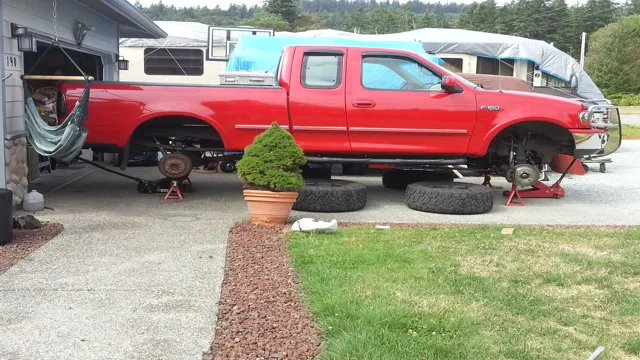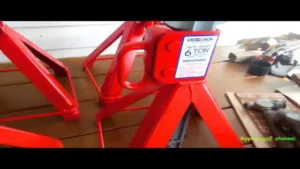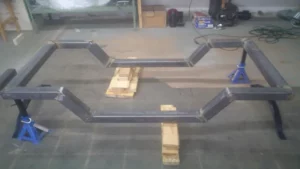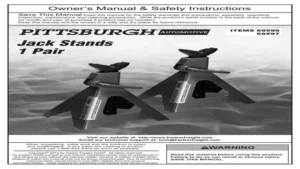If you’re a truck enthusiast, you know that maintenance is key to keeping your vehicle running smoothly. Whether you’re changing the oil, replacing brake pads, or doing any other work underneath your truck, jack stands are a must. But if you’ve never used jack stands before, the process can seem daunting.
Don’t worry, though – with a little bit of know-how, putting your truck on jack stands is a straightforward process that just about anyone can handle. In this article, we’ll walk you through the steps involved in safely raising your truck with jack stands, so you can tackle all your necessary repairs with confidence. So grab your tools, let’s get started!
Preparation
If you need to perform maintenance or repairs on your truck, it’s essential to know how to put it on jack stands safely. Firstly, park on level ground and engage the parking brake. Next, chock the wheels that aren’t being lifted to prevent the truck from rolling.
Then, locate the manufacturer-recommended lifting points underneath the truck. Placing the jack stands on these points will distribute the weight evenly and minimize the risk of damage. Before lifting the truck, test the stability of the jack stands by giving them a gentle shake.
Once you’re sure they’re secure, use the jack to lift the truck and place the stands on the recommended points. Slowly lower the truck onto the stands, making sure they’re secure before crawling underneath. Finally, do not rely solely on jack stands to support your vehicle indefinitely, as they may shift over time.
Gather Tools & Materials
When preparing to gather tools and materials for your project, it’s important to take the time to carefully plan and assess your needs. First, think about the type of project you are undertaking and make a list of the tools and materials you will need. Don’t forget to include any safety equipment or protective gear that may be necessary.
Next, consider your budget and the availability of the tools and materials you need. If you don’t already have the necessary tools, consider borrowing or renting them to save money. When it comes to materials, be sure to choose high-quality options that will provide the best results for your project.
Remember to factor in any additional time needed for gathering and preparing your tools and materials, as this can impact your overall timeline. With careful planning and preparation, you can ensure that you have everything you need to successfully complete your project. By taking the time to gather the right tools and materials, you’ll be able to work efficiently and effectively, while producing high-quality results.

Choose a Safe Location
When choosing a safe location, preparation is key. It’s important to consider various factors such as the environment, accessibility, and the level of security available. If you’re traveling to a new destination, research the area and find out which areas are considered safe and which ones are not.
Look for neighborhoods that are well-lit, have a visible security presence, and are frequently patrolled. If you’re staying in a hotel, choose a room that’s located on a higher floor and away from emergency exits. It’s also a good idea to make sure that your accommodations are equipped with the necessary safety features such as secure doors and locks, fire alarms, and smoke detectors.
By taking the time to prepare and choose a safe location, you can help ensure that your trip is enjoyable and stress-free.
Set the Emergency Brake & Chock the Wheels
When it comes to vehicle safety, preparation is key. Before performing any maintenance or repairs, it’s essential to set the emergency brake and chock the wheels. This applies not only to cars but also to trucks, trailers, and other heavy equipment.
Doing so will prevent any unintended movement of the vehicle, protecting you from injury and preventing damage to the vehicle. Chocking the wheels involves placing wedges beneath the wheels to keep the vehicle stationary, even on an incline. This step is especially important when working on uneven surfaces or on a slope.
Setting the emergency brake alone may not provide enough stability, so it’s best to do both. Overall, taking the time to prepare your vehicle correctly will ensure a safe and successful repair or maintenance job.
Lifting the Truck
Putting a truck on jack stands can be a bit daunting, especially if it’s your first time. But fear not, with a little know-how and the right tools, you can get the job done in no time. First, ensure that you have a level surface to work on and that the truck is in park with the emergency brakes engaged.
Next, locate the designated jack points (usually indicated in the owner’s manual or on the vehicle itself) and place the jack under one of these points. Slowly jack up the truck until both wheels on one side are off the ground. Place a jack stand under the same jack point and slowly lower the truck onto the stand, making sure it is secure.
Repeat the process on the other side of the vehicle. It’s always better to be safe than sorry, so double-check that the truck is stable before crawling underneath. And remember, never rely solely on a jack to support the weight of the vehicle – always use jack stands for added support.
Locate Jack Points on the Truck
If you’re planning to lift your truck, you need to know where to locate the jack points. These are essential areas where you can place the jack when lifting the truck. The jack points are usually located on the frame rails under the truck.
They may also be located on the front or rear axles. It’s important to locate the proper jack points to avoid damaging the truck’s undercarriage or hurting yourself during the lifting process. You can find information on the jack points location either in your truck’s owner’s manual or online.
Once you’ve located the jack points, ensure that the jack you’re going to use can lift the weight of your truck. Lifting a truck requires caution and care, so take your time and be careful to follow proper lifting procedures. By doing so, you can enjoy the benefits of having a lifted truck without any problems.
Position the Jack under the Jack Point
When it comes to lifting your truck, safety is of utmost importance. Before even starting to jack your truck up, make sure you’re following the manufacturer’s instructions. Once you’re sure you’re following the correct process, it’s time to position the jack under the jack point.
The jack point can usually be found either just behind the front wheels or just in front of the rear wheels. If you’re unsure, consult your owner’s manual or the manufacturer’s website for specifics. Once you’ve identified the jack point, place the jack under it carefully.
You want to make sure the jack is firmly in place before beginning to lift the truck. The last thing you want is for the jack to slip and the truck fall. Take your time and make sure everything is secure before proceeding.
By following these simple steps, you can safely and effectively lift your truck, allowing you to perform maintenance or make repairs as needed.
Slowly Lift the Truck with the Jack
When lifting a truck with a jack, it’s important to do it slowly and carefully to avoid any accidents or damage to the vehicle. First, make sure the jack is securely in place under the designated lifting point of the truck, which is usually indicated in the owner’s manual. Then, start pumping the jack handle to slowly lift the vehicle off the ground.
Keep an eye on the jack and make sure it’s not leaning or wobbling, as this can be dangerous. Continue pumping the jack handle until the truck is at the desired height for the job you’re doing, whether it’s changing a tire or inspecting the undercarriage. Remember to always use a jack stand to support the weight of the truck once it’s lifted, as jacks are not meant to hold vehicles for extended periods of time.
With patience and caution, lifting a truck with a jack can be done safely and effectively.
Placing the Truck on Jack Stands
Putting a truck on jack stands is a straightforward task, but it requires precision and caution to ensure safety. The first step is to find a flat and level surface, away from traffic, and put the vehicle in park or reverse gear with the handbrake on. Then, locate the jacking points specified in the owner’s manual for your truck.
These are usually marked by notches or arrows on the chassis, near the wheels. Use a hydraulic or bottle jack to lift one side of the truck at a time, placing the jack under the jacking point and pumping it until the wheel is off the ground. Once the wheel is lifted, slide the jack stand under the truck’s frame, as close to the jacking point as possible, and adjust its height to match the height of the jack.
Then, gently lower the truck onto the jack stand and repeat the process for the other side. Before working under the vehicle, give it a gentle shake to ensure that the jack stands are secure and well-positioned. Finally, remember to lower the truck back onto its wheels before removing the jack stands or the jack.
By following these steps, you can safely put your truck on jack stands and work on its undercarriage without any issues.
Locate Jack Stand Points on the Truck
Placing the truck on jack stands can be intimidating, but it’s essential for performing work safely. Before getting started, it’s important to locate sturdy and stable points on your truck where you can place the jack stands. You should consult your truck’s manual for jack stand points, but generally, the manufacturer will indicate areas underneath the frame or axle where it’s safe to place stands.
This will ensure that the weight of the truck is evenly distributed and stable. It’s important to choose the right size jack stands for your truck according to its weight capacity. Once you’ve located the jack stand points, place the stands according to the instructions carefully.
Never jack the truck from any other points as it can damage the vehicle’s underbody, making it difficult and even dangerous to work on. Always double-check the stability of the stands before attempting any work after placing the truck on jack stands. With this, we can safely and efficiently work on our trucks and make sure all repairs and maintenance are done correctly.
Position the Jack Stands under the Jack Stand Points
When it comes to working on your truck, ensuring proper safety measures is critical. Placing the truck on jack stands is one such precaution to avoid mishaps while working under the vehicle. The process involves identifying the jack stand points, which are marked in the owner’s manual or on the body of the truck.
Once you’ve identified them, position the jack stands securely on a flat surface beneath these points. Make sure there is enough clearance between the stands and the vehicle to allow you to work freely and safely. Remember to use the appropriate jack stands based on the weight and size of your truck.
By following these steps, you’ll be able to lift your truck safely on jack stands, and work on it with confidence, knowing that the stands are supporting the weight of the vehicle entirely.
Slowly Lower the Truck onto the Jack Stands
When it comes to placing your truck on jack stands, the process can seem daunting, but with a little patience and planning, it can be done safely. The first step is to ensure that the ground is level and stable. Next, locate the jacking points on the vehicle by consulting the owner’s manual or a reputable online resource.
Once you have identified the jacking points, use the jack to raise the truck just high enough to allow the jack stands to be placed securely under each jacking point. The key here is to slowly and carefully lower the truck onto the jack stands. Once the vehicle is resting securely on the jack stands, give it a slight push to ensure that it is stable.
Remember, safety always comes first when working under a vehicle, so take your time and double-check everything before getting to work. By following these simple steps, you can safely place your truck on jack stands and get to work on maintaining or repairing your vehicle as needed.
Safety Tips
If you need to put your truck on jack stands for maintenance or repairs, it’s essential to follow proper safety procedures. Start by parkinging on a level surface and engage the emergency brake to prevent any movement. Then, choose a sturdy and level jack stand that can handle the weight of your truck.
Before lifting the vehicle, test the jack stand by jiggling it to make sure it’s secure. Raise the truck with a jack, making sure not to exceed the maximum weight capacity of the jack. Once the truck is lifted, place the jack stand under a solid part of the frame, like the heavy-duty metal bars.
Slowly lower the truck onto the stand and test it again by giving it a gentle shake. Always use a second jack stand as a backup to help prevent accidents. When you’re done, reverse the process and slowly lower your truck back onto the ground.
By following these tips and taking precautions, you can safely and successfully put your truck on jack stands.
Double Check Stability of Jack Stands
When it comes to working on your car, safety should always be your top priority. One crucial aspect of that is ensuring that your jack stands are stable and reliable. Before you get under your car, it’s essential to double-check that your stands are positioned correctly and securely holding the weight of your vehicle.
You don’t want any sudden movements or shifts that could put you in danger. Make sure that you choose stands that can support the weight of your car, and that they are on level ground. Additionally, check that the height is appropriate for the work you’ll be doing- not too high or too low.
Your safety is important, so never rush the process or take shortcuts. Take the extra time to verify your jack stands are stable and reliable, and you’ll be able to complete your repairs with confidence that you’re doing it safely. Remember, a few extra minutes spending on safety measures will go a long way in preventing accidents.
Test Jack Stands Before Working on the Truck
When it comes to working on your truck, one of the first things you need to do is to make sure you have a reliable set of jack stands. These tools are essential for keeping your vehicle steady and preventing accidents. However, it’s important to test your jack stands thoroughly before using them.
To do this, place them on a level surface and check that they’re stable enough to support your truck’s weight. You can also use a hydraulic jack to lift one side of the truck slightly, just to check that the jack stands are able to hold it in place. This simple safety check can save you from serious injury or damage to your truck in the long run.
Remember, using a faulty set of jack stands is never worth the risk. Keep yourself and your vehicle safe and sound by testing your jack stands before getting started.
Do Not Work Underneath the Truck While on Jack Stands
When it comes to working on your truck, safety is key. One important tip to keep in mind is to never work underneath the vehicle while it’s supported by jack stands. Even if the stands seem secure, it’s always better to err on the side of caution and avoid putting yourself in harm’s way.
Jack stands can be unpredictable and can shift or collapse, especially if they are old or worn out. It’s recommended to use additional safety measures, such as wheel chocks or blocks, to keep the truck from rolling or shifting while you work. To ensure your safety while working under your truck, always follow the manufacturer’s guidelines for jack stand placement and usage.
By taking the necessary precautions, you can keep yourself safe and enjoy a worry-free truck maintenance experience.
Lower the Truck Carefully When Work is Finished
When it comes to working with trucks, safety should always be a top priority. Lowering the truck carefully at the end of the job is just as important as any other part of the task. This ensures that everyone involved remains healthy and safe.
There are several ways to lower the truck securely. First, make sure you have an unobstructed path where there are no ditches, wires, or other objects that could cause an accident. Next, use a spotter to keep an eye out for anything that might get in the way and to communicate effectively with the driver.
Finally, make sure the truck bed is empty and the brakes are functioning correctly before beginning to lower it. Lowering the truck should be done slowly and steadily, in stages if necessary, to ensure that everything goes smoothly. Taking precautions like these can prevent accidents and keep everyone safe on the job.
Conclusion
In conclusion, putting a truck on jack stands is not rocket science. It may seem intimidating at first, but by following these simple steps, you can effortlessly lift your truck and get that perfect angle for tinkering with the undercarriage. So let’s get jacking and leave the frustratingly low clearance behind us!”
FAQs
What equipment do I need to put a truck on jack stands?
You will need a hydraulic jack, two jack stands rated for your truck’s weight, and wheel chocks.
How do I choose the right place to position the jack stands on my truck?
Refer to your truck’s owner’s manual to locate the recommended jacking points. These are usually on the frame or suspension.
Is it safe to work under a truck supported only by jack stands?
It is generally safe as long as you take proper precautions, such as using high-quality jack stands, ensuring a stable ground surface and not exceeding the weight limit.
How do I jack up a truck and put it on the stands?
Park on a level surface, engage the emergency brake, place wheel chocks, jack up the front or rear of the truck using a hydraulic jack, and place jack stands.
Can jack stands damage my truck’s undercarriage?
Jack stands can damage the undercarriage if placed in the wrong spot or if they fail. Follow the recommended jacking points and use jack stands rated for your truck’s weight.
Can I leave a truck on jack stands for an extended period?
It is not recommended to leave a truck on jack stands for an extended period because they can shift or fail. Only use jack stands for short-term repairs or maintenance.
How do I safely lower a truck from jack stands?
Position yourself away from the truck, remove any tools or parts from underneath, lower the vehicle slowly and evenly onto the ground, and remove the jack stands.






